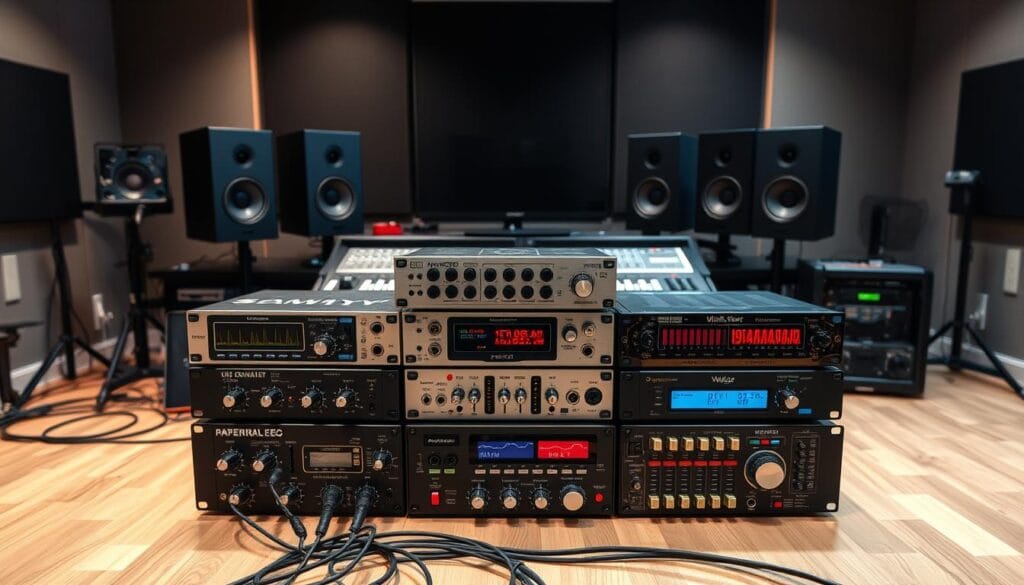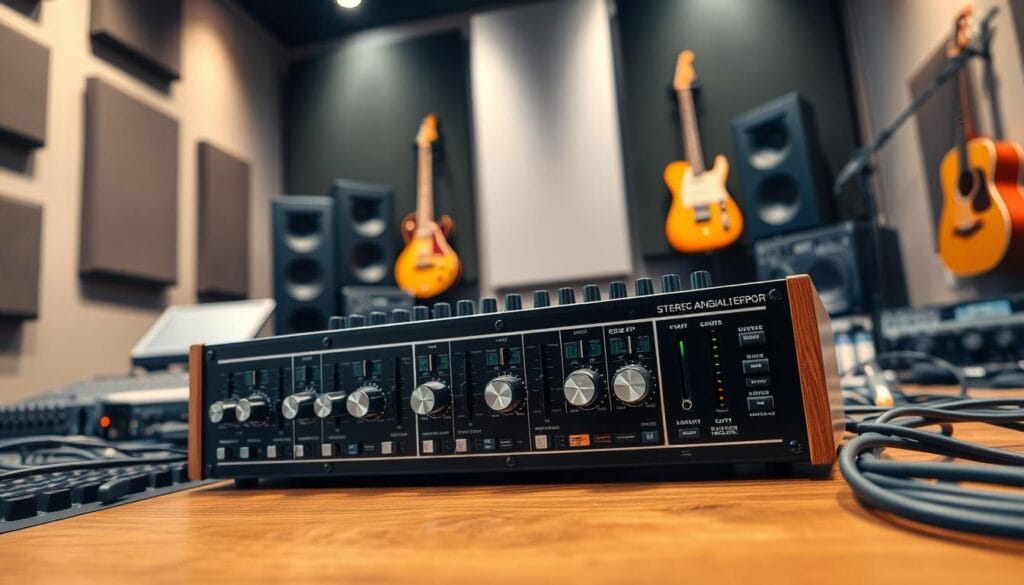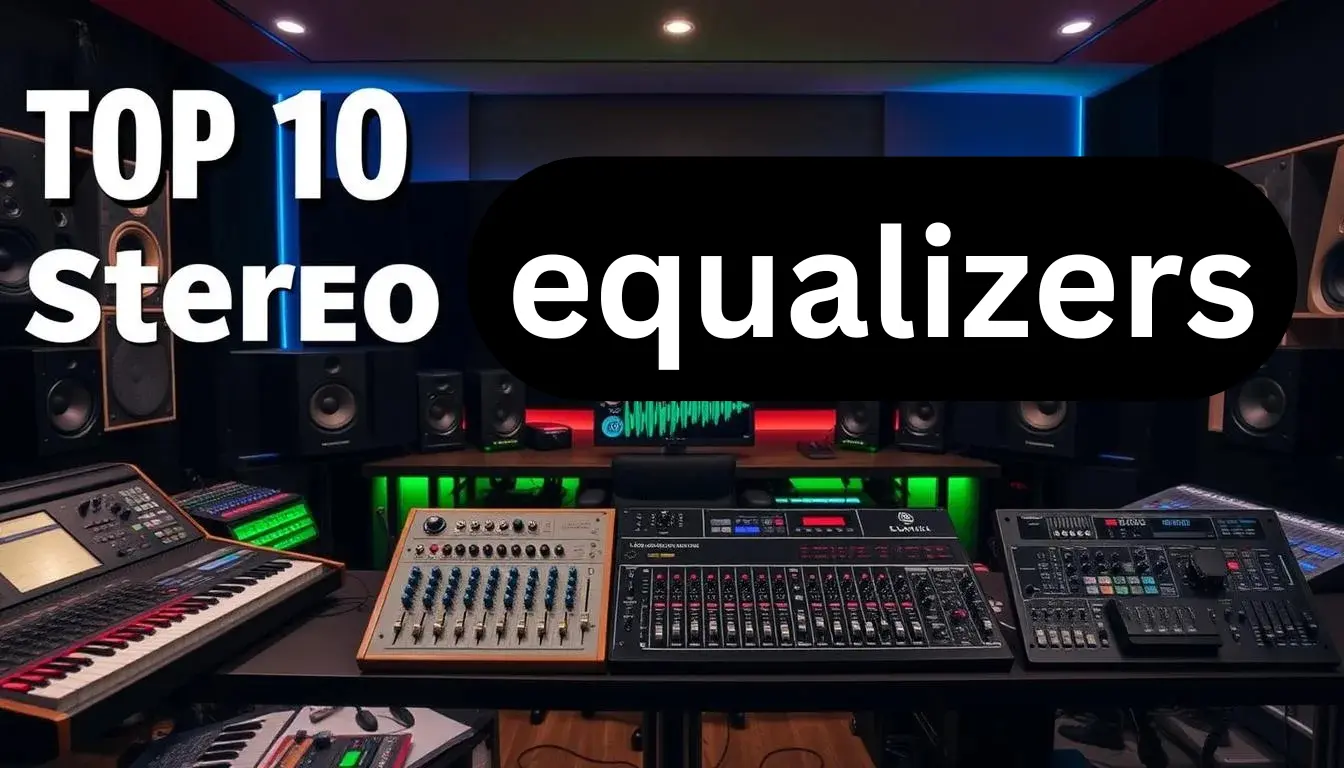Imagine walking into your studio with a clear idea of the perfect sound. Every note and beat sounds just right. As someone who loves audio, you know how hard it can be to get the sound just right.
Whether you’re a pro producer or just starting out, the right stereo equalizer can change everything. This guide will help you find the best tools for your studio. They’ll help you get that perfect balance and clarity in your music.
Table of Contents
Introduction to Stereo Equalizers
Stereo equalizers are key in sound engineering. They help make audio sound balanced and clear. By adjusting frequency bands, they improve sound quality in many areas.
It’s important to know the differences between various stereo equalizers. This knowledge helps you use them to their fullest potential. Whether you’re searching for the best studio equalizers or just starting, you’re in the right place.
Equalizers come in different types, like graphic and parametric. Graphic equalizers have many sliders, making them easy to use. They’re often used in live shows and for monitoring.
Parametric equalizers, on the other hand, offer more detailed control. They’re common in recording studios but need more skill to use. The Mäag Audio EQ4 is an example of a top-notch studio equalizer.
The history of equalizers is fascinating. They’ve evolved from early telegraphy to modern audio tools. The 1970s saw the introduction of parametric equalizers, which changed audio processing forever.
Today, parametric equalizers are digital and available as plugins. They’re crucial in many fields, from recording to live sound. Understanding how they work can greatly improve your sound quality.
If you want to learn more, a stereo equalizer comparison is a good start. By exploring different types, you can find the best equalizers for your needs. This will help you improve your audio engineering skills.
Benefits of Analog Equalizers for Studio Use
Analog equalizers are key in top studios for their warm, natural sound and precise control. These qualities are crucial for the best audio in professional settings. Let’s dive into why analog equalizers are a must in studios.
Warm, Natural Sound
Analog equalizers are known for their warm, natural sound. This is thanks to early designs like the 1073, which uses inductors for a unique sound. These parts add a nice distortion, making the sound feel more organic.
The Pultec EQP-1, from the 1950s, also adds a rich, warm sound to recordings. Even today, modern versions like the Lindell Audio PEQ-501A and the Source Audio ZIO Analog Front End + Boost pedal aim to keep this special sound.
Precise Frequency Control
Analog equalizers give audio engineers precise control over sound. For example, the Pultec EQP-1 has filters that let you fine-tune specific frequencies. This makes them some of the best in the business.
Tools like the Waves PuigTec EQs also offer emulations of these classic designs. This shows how valuable and precise high-quality studio EQs are.
Best Budget Stereo EQs
Finding a great stereo eq for recording studio on a budget is tough. But, we’ve found some amazing options that won’t empty your wallet. These are perfect for new artists and small studios looking for quality without the high cost.
Many people recommend the API 5500 for its amazing sound and reliability. It’s under $2500 and is often talked about as the best in its price range. The TK Audio TK-Lizer and Heritage Audio Symph are also great choices. They offer excellent sound and are versatile.
The PuigTec EQs and Scheps 73 EQ are new and affordable. They’re priced at $29.99 and have great reviews. They’re known for their quality and value.
“The F6 Floating-Band Dynamic EQ, currently available for $35.99 with a 76% discount, is an excellent choice, featuring a 4.78 average rating from 962 reviews.”
The SSL E-Channel is also a great deal at $35.99. It’s highly rated by users, with a 4.86 from 989 reviews. It’s a top pick for those on a budget.
If you want to add color and character to your sound, check out the Electrodyne 2511 and Tube Tech HLT2A. They’re affordable but still deliver top-notch sound.
The Kramer HLS Channel EQ is another great choice. It’s $29.99, down from $149. It’s praised for its versatility and sound quality, with a 4.77 rating from 193 reviews.
Looking for the best studio equalizers on a budget doesn’t mean you have to settle. With these options, you can improve your recording studio without spending too much. You’ll get professional sound at a price that’s easy on your wallet.
Midrange Stereo EQs for Professional Studios
For professional studios, midrange stereo equalizers are a great choice. They balance cost and performance well. This section will cover key features and top picks from leading brands.
Key Features to Consider
When choosing a midrange stereo EQ, several features are crucial. They impact performance and user experience. Here are important attributes to look for:
- Frequency Response: A wide and flat frequency response is key. It ensures the EQ works well with various audio signals without coloration or distortion.
- Build Quality: A sturdy build is essential for durability. Professional studios use equipment a lot, so it needs to last.
- Connectivity Options: Having flexible connectivity is important. Options like balanced and unbalanced inputs/outputs make integration with other studio gear easy.
Top Picks in the Midrange Category
This guide highlights the best midrange stereo EQs. They offer great value for their price. Here are some notable products and their key features:
| Product | Price | Key Features |
|---|---|---|
| Heritage Audio Herchild HA670 Ardent Edition | $10,999 | Exceptional stereo tube compression; perfect for adding warmth and depth to mixes. |
| HUM Audio LAAL Look Ahead Analog Limiter | $9,500 | Transparent sound with advanced limiting capabilities; versatile use in mastering and mixing. |
| Universal Audio Apollo x16 Gen 2 Thunderbolt Audio Interface | $4,999 | Top-notch A/D conversion and extensive I/O options for comprehensive studio integration. |
| Apogee Symphony Studio 8×16 USB-C Audio Interface | $3,499 | High-resolution audio quality with flexible connectivity; perfect for professional setups. |
These midrange stereo EQs are great for professional studios. They offer quality, performance, and value. Adding any of these EQs will improve your studio’s sound quality and reliability.
High-End Stereo EQs for Experts
For sound engineers and studio pros, top-notch stereo EQs are a game-changer. These high-quality studio eqs offer unmatched precision and clarity. They’re key for any advanced audio setup.
Why Invest in High-End EQs
High-end stereo equalizers are worth it for their top-notch build and performance. They let you tweak audio signals with great detail. For example, the Fairchild Recording Equipment 670 costs $35,000 but offers unmatched features.
This ensures sound accuracy and warmth in your work.
Pinnacle of Precision and Quality
Top EQs are the best in precision and quality. They use advanced parts and careful engineering. The IGS 825EQ Mastering Equalizer, for instance, is a favorite for its precise control.
Other high-end items like the Universal Audio Apollo x16 Gen 2 and the Apogee Symphony Studio 8×16 offer top audio fidelity and seamless integration.
| Product | Regular Price | Discounted Price | Key Features |
|---|---|---|---|
| Fairchild Recording Equipment 670 Dual-Channel Compressor/Limiter | $35,000 | None | Ultimate sound control and compression |
| IGS 825EQ Mastering Equalizer | $3,795.00 | $3,225.75 (Holiday Sale) | Precision frequency control |
| Universal Audio Apollo x16 Gen 2 Thunderbolt Audio Interface | $4,999 | None | High-definition audio interfacing |
| Apogee Symphony Studio 8×16 USB-C Audio Interface | $3,499 | None | Superior build, seamless integration |
Top 10 Stereo EQs for Studio Operations

Finding the right audio equalizer is key for studio operations. This review covers the top 10 stereo EQs for studio operations
| Model | Description | Pros | Cons |
|---|---|---|---|
| TDR EQ series | Top free stereo EQs with advanced features for precise control. | High precision, free | Requires learning curve |
| HoRNet TreBande | Great for various mixing needs with a simple interface. | Easy to use, versatile | Basic design |
| Photosounder SplineEQ | Advanced equalization with spline-based EQ curves. | Highly flexible, intuitive | Not beginner-friendly |
| Melda Production MEqualizer | Known for its graphical interface and saturation feature. | Graphic interface, saturation | Complex for novices |
| ViatorDSP EQ | Focuses on vintage character with a simple, colorful design. | Vintage sound, user-friendly | Limited advanced settings |
| Analog Obsession EQ | Captures the essence of analog outboard gear. | Authentic analog sound | Hefty CPU usage |
| Behringer Ultragraph Pro FBQ1502HD | 15-band graphic equalizer with balanced connectivity. | Balanced connectivity, rack-mountable | Bulky design |
| EBM EB631EQ Graphic Equalizer | 31-band EQ for stereo processing with basic build. | Comprehensive frequency control | Minimal advanced features |
| DBX 231s | Popular for live sound with 31-band equalization. | Extensive frequency range | Designed more for live sound than studio |
| Neve 551 | Highly regarded Neve style outboard EQ. | Superior sound quality | Expensive |
Each top rated audio equalizer has unique features for different studio needs. Whether you want vintage sound, precision, or ease of use, this list helps you find the best EQ. The right equalizer can greatly improve your audio production, enhancing sound quality.
Factors to Consider When Choosing a Stereo EQ
Choosing the right stereo EQ for your recording studio is key. It greatly affects the quality of your audio. There are important factors to consider to make the right choice.
Audio specifications are crucial. Most EQs work in the 20Hz to 20kHz range. Knowing this range helps you make precise adjustments to improve your sound.
When comparing EQs, look at the filter types. You’ll find high/low pass, bell, notch, and high/low shelf filters. Each has its own use. Knowing how to use them can greatly improve your audio.
Quality factor (Q) is also important. It controls how narrow or wide an EQ band is. Higher Q values (above 1) give tighter boosts or cuts. This is useful for focusing on specific frequencies. The gain, measured in dB, shows how much you’re boosting or cutting. It’s key for fine-tuning your audio.
The EQ’s interface is another factor. A good interface makes adjustments easier and faster. This is crucial in a busy recording studio where time is precious.
Make sure the EQ works well with your other studio equipment. Before buying, check if it fits with your setup. This avoids problems and ensures smooth operation.
Your budget constraints also matter. While expensive EQs have more features, cheaper ones can still perform well. Think about what you need and how much you can spend to make a good choice.
| Factor | Considerations |
|---|---|
| Audio Specifications | Frequency range from 20Hz to 20kHz |
| Filter Types | High/Low pass, Bell, Notch, High/Low shelf |
| Quality Factor (Q) | Values above 1 for tighter boosts/cuts |
| Gain | Boost or cut measured in dB |
| Interface Usability | User-friendly controls |
| Compatibility | Seamless integration with existing equipment |
| Budget Constraints | Balance between needs and budget |
Remember these factors when picking a stereo EQ for your studio. Whether you’re new or experienced, understanding these points helps you choose the best EQ for superior sound quality.
Essential Accessories to Complement Your Stereo EQ
Getting the most out of your stereo EQ for a recording studio is more than just the unit. You need the right accessories to boost your audio quality. We’ll talk about must-haves like connecting cables and the best setup to make your professional stereo EQ reviews shine.
Connecting Cables
Choosing the right connecting cables is key for clear audio. High-quality cables cut down on noise and keep your signal strong. XLR cables are top picks for their balanced connections, which help keep the sound clear over long distances.
Gold-plated connectors also improve conductivity and last longer. They’re a great choice for your cables.
Know the Right Setup
Setting up your stereo EQ right can greatly improve your sound. It’s important to arrange your gear to get the most out of your EQ. Make sure your setup is organized, shielded from interference, and all connections are tight and clean.
Experts say a well-organized setup is crucial for the best sound. It’s all about efficiency and quality.

Conclusion
In this guide, we’ve looked at stereo equalizers in-depth. We’ve shown you the best studio equalizers for your studio. You’ll find options for every budget, from affordable to top-of-the-line.
We talked about both analog and digital EQs. Plugins like FabFilter Pro-Q3 and iZotope Ozone 11 EQ were highlighted for their great features. We also discussed analog emulation plugins, like the Tube-Tech Equalizer Collection, for their ability to mimic classic hardware.
Dynamic EQs were mentioned for their ability to adjust sound in real-time. This is crucial for mixing and mastering. We also covered the importance of accessories to set up your EQs for the best performance.
Whether you’re new or experienced, there’s a studio equalizer for you. By choosing the right one, you can improve your music production. Investing in quality EQs can take your music to the next level.
FAQ
What are the top 10 stereo EQs for studio operations?
The top 10 stereo EQs for studios range from affordable to high-end. You’ll find options like the API 5500 and Neve 8803. Each EQ has unique features for different studio needs.
How do stereo equalizers enhance audio quality in a recording studio?
Stereo equalizers adjust the sound’s frequency balance. This makes the audio clear and pleasing, key for professional recording.
What is the advantage of using analog equalizers in a studio environment?
Analog EQs give a warm, natural sound. They offer precise control and keep the audio’s integrity, perfect for detailed sound shaping.
Are there affordable stereo EQ options that still provide high quality?
Yes, brands like ART and dbx offer affordable, high-quality EQs. They’re great for new artists and small studios.
What are some key features to consider in midrange stereo equalizers?
Look for frequency response, build quality, and connectivity options in midrange EQs. These ensure the EQ works well with various inputs and outputs.
Why should an audio professional invest in high-end stereo EQs?
High-end EQs offer superior precision and quality. They’re great for detailed adjustments and advanced features, worth the cost for professionals.
What factors should be considered when choosing a stereo EQ?
Consider audio specs, interface usability, compatibility, and budget. These help choose the right EQ for your needs.
What are the essential accessories to use with a stereo EQ?
You’ll need high-quality cables and understand your studio setup. These ensure your EQ works well and sounds great.
Which brands are top-rated in the stereo EQ market?
Top brands include API, Neve, Manley, and SSL. They’re known for high-quality EQs used by professionals.
How do analog EQs compare to digital models in terms of audio quality?
Analog EQs are known for their warm, natural sound. Digital EQs offer flexibility and precision, good for different tasks.
